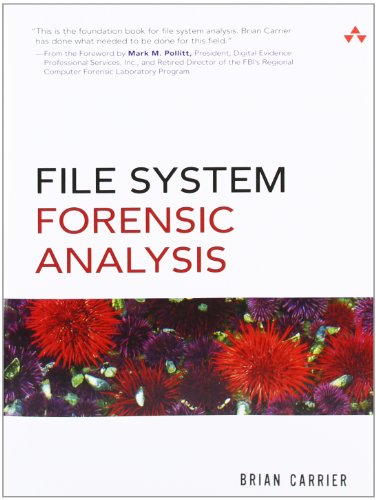File System Forensic Analysis pdf download
Par pierce karen le mardi, décembre 22 2015, 23:16 - Lien permanent
File System Forensic Analysis by Brian Carrier


File System Forensic Analysis Brian Carrier ebook
ISBN: 0321268172, 9780321268174
Format: chm
Publisher: Addison-Wesley Professional
Page: 600
Memory Forensics; Computer Forensic Tools; Evidence Recovery of Windows-based Systems; Hard Disk Evidence Recovery & Integrity; Evidence Analysis & Correlation; Digital Device Recovery & Integrity; and File System Forensics. File system, in addition, can also be used to hide data. So I decided to fire up the old hex editor and see for myself. The $UsnJrnl file contains a wealth of information about file system activity which can provide more context about what occurred on a system. File System Forensics by Brian Carrier. Autopsy automates many of the tasks required during a digital forensic analysis using the TASK collection of powerful command line tools as a foundation. Infinite Skills Learning Computer Forensics English | Mp4 | h264 | 1280x720 | 25.00 fps | Mp3 128kbps 48000hz | 1.75Gb Genre: Video Tutorials This video based Computer Forensics training. Nazarijo writes “The field of investigative forensics has seen a huge surge in interest lately, with many looking to study it because of shows like CSI or the increasing coverage of computer-related crimes. This paper goes into great detail describing the PlayStation Portable and its capabilities, accessories, and. I have been spending some time reading File System Forensic Analysis by Brian Carrier which is considered by many to be the primary resource on the subject of file system forensics. 0405 Boot Processes 0406 File Systems: Windows-Based 0407 File Systems: Linux 0408 File Systems: Mac OS 0409 File Systems: CD 0410 RAID 0411 Autostarting 0412 Executable Types And Structure: Windows 0413 Executable Types And Structure: Unix-Based 0414 Disk Partitions 05. I'm excited to announce that my proposed tutorial on file system analysis was accepted for the 22nd Annual FIRST Conference. For example, chapter 4 is dedicated to the HFS+ file system used by Macintosh computers and drills down to disk level file system forensics. Understanding EXT4 (Part 1): Extents · 3 comments Posted by Hal Pomeranz Filed under artifact analysis, Computer Forensics, Evidence Analysis While I had read some of the presentations[2] related to EXT4, I was curious about how the EXT4 structures actually looked on disk and how and why the changes made in the EXT4 file system broke existing forensic tools. The most famous ways are data encryption and steganography. Back when I was first figuring out how to acquire the Samsung Galaxy Camera, I did a file system dump using Cellebrite's UFED Logical. Fundamentals of Modern Operating Systems Introduction & Forensics Investigations Handbook of Digital Forensics and Investigation, by Eoghan Casey, Elsevier Academic Press. I had recently completed Brian Carrier's, “File System Forensic Analysis,” (also an amazing book) and was looking for something a bit less in-depth and more of a general digital forensics book.